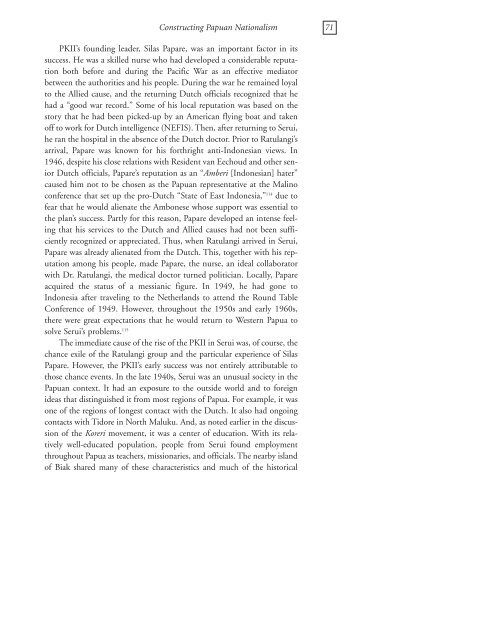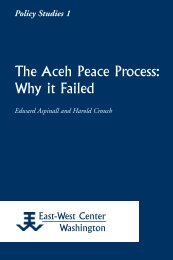Constructing Papuan Nationalism: History, Ethnicity ... - ScholarSpace
Constructing Papuan Nationalism: History, Ethnicity ... - ScholarSpace
Constructing Papuan Nationalism: History, Ethnicity ... - ScholarSpace
- No tags were found...
Create successful ePaper yourself
Turn your PDF publications into a flip-book with our unique Google optimized e-Paper software.
<strong>Constructing</strong> <strong>Papuan</strong> <strong>Nationalism</strong> 71PKII’s founding leader, Silas Papare, was an important factor in itssuccess. He was a skilled nurse who had developed a considerable reputationboth before and during the Pacific War as an effective mediatorbetween the authorities and his people. During the war he remained loyalto the Allied cause, and the returning Dutch officials recognized that hehad a “good war record.” Some of his local reputation was based on thestory that he had been picked-up by an American flying boat and takenoff to work for Dutch intelligence (NEFIS). Then, after returning to Serui,he ran the hospital in the absence of the Dutch doctor. Prior to Ratulangi’sarrival, Papare was known for his forthright anti-Indonesian views. In1946, despite his close relations with Resident van Eechoud and other seniorDutch officials, Papare’s reputation as an “Amberi [Indonesian] hater”caused him not to be chosen as the <strong>Papuan</strong> representative at the Malinoconference that set up the pro-Dutch “State of East Indonesia,” 114 due tofear that he would alienate the Ambonese whose support was essential tothe plan’s success. Partly for this reason, Papare developed an intense feelingthat his services to the Dutch and Allied causes had not been sufficientlyrecognized or appreciated. Thus, when Ratulangi arrived in Serui,Papare was already alienated from the Dutch. This, together with his reputationamong his people, made Papare, the nurse, an ideal collaboratorwith Dr. Ratulangi, the medical doctor turned politician. Locally, Papareacquired the status of a messianic figure. In 1949, he had gone toIndonesia after traveling to the Netherlands to attend the Round TableConference of 1949. However, throughout the 1950s and early 1960s,there were great expectations that he would return to Western Papua tosolve Serui’s problems. 115The immediate cause of the rise of the PKII in Serui was, of course, thechance exile of the Ratulangi group and the particular experience of SilasPapare. However, the PKII’s early success was not entirely attributable tothose chance events. In the late 1940s, Serui was an unusual society in the<strong>Papuan</strong> context. It had an exposure to the outside world and to foreignideas that distinguished it from most regions of Papua. For example, it wasone of the regions of longest contact with the Dutch. It also had ongoingcontacts with Tidore in North Maluku. And, as noted earlier in the discussionof the Koreri movement, it was a center of education. With its relativelywell-educated population, people from Serui found employmentthroughout Papua as teachers, missionaries, and officials. The nearby islandof Biak shared many of these characteristics and much of the historical
















